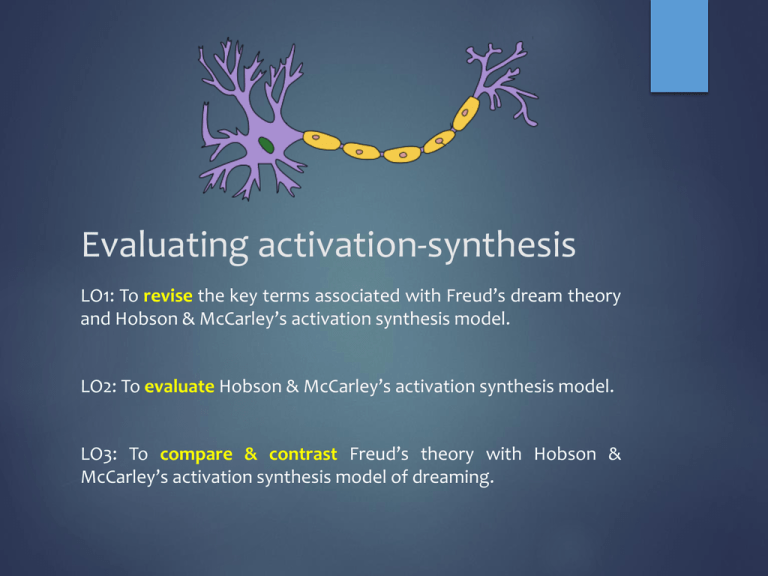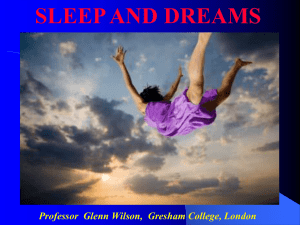File
advertisement

Evaluating activation-synthesis LO1: To revise the key terms associated with Freud’s dream theory and Hobson & McCarley’s activation synthesis model. LO2: To evaluate Hobson & McCarley’s activation synthesis model. LO3: To compare & contrast Freud’s theory with Hobson & McCarley’s activation synthesis model of dreaming. New term…new seats… WHITEBOARD Farhan Jaimie I Hannah Jabesh Boglarka Daniya Jaime P Fabian Xhoi Nathan Jess Zoe Nii Alan Pranita Ellie Gurkiran Molly Tilly Maya Ryan Jenorth Robert Previous Draw the table below and sift the word soup by placing each of the 16 key terms into one of the two dream theories. Key terms Freud Hobson & McCarley 1. Sensory Blockade 2. Random Activation Once you have sifted the key words make sure you know what each word means… 4. Free Association 3. REM Sleep 5. Pons 7. Secondary Elaboration 6. Neurons 8. Displacement 9. Synthesis 10. Condensation 11. Dream Analysis 12. Dreamwork 13. Reticular Activating System 14. Slip of the tongue 15. ECG 16.Electroencephalograph Soup of the day… Key terms Freud Hobson & McCarley 4. Free association 7. Secondary elaboration 8. Displacement 10. Condensation 11. Dream analysis 12. Dreamwork 14. Slip of the tongue 1. Sensory blockade 2. Random activation 3. REM sleep 5. Pons 6. Neurons 9. Synthesis 13. Reticular activating system 16. Electroencephalograph (EEG) Quiz 1 – What was your mark? Be ready to tell me your mark out of 10 on the quiz we completed at the end of last term. Evaluating Hobson & McCarley Last lesson you created a table of strengths and weaknesses. To ensure you have AT LEAST two key points read the strengths and weaknesses around the room. Decide whether the following key points are strengths and weaknesses and then summarise these in your table, using the information around the room: Regular REM Sleep Development of activation-synthesis Testing cats…how could they? Activation-synthesis is not so random Lucid dreaming Children and dreaming Strengths Weaknesses Strengths 1) Regular REM Sleep Hobson & McCarley provide an explanation for the regularity of REM sleep. During REM sleep people have movement inhibition and sensory blockade, so there must be something happening in the brain during REM sleep to produce dreams. They explained this through the random activation of neurons. Why is this a strength? Strengths 2) Development of activation-synthesis Hobson and McCarley’s theory has been continually developed. Hobson said that he thought there was ‘meaning’ in dreams and that some ideas generated by the brain from the random ‘firing’ of neurons could be useful and give the individual new ideas. Thus, there may be an advantage of dreaming that has been passed on through natural selection. E.g. If you wake up with a good idea it might have come from your dreams. Why is this a strength? Strengths (continued) 3) Testing cats…how could they? Hobson and McCarley tested cats to see which areas of the brain were active during REM sleep. They found that the pons and the reticular activating system (RAS) seem to be involved in shutting down physical movement during REM sleep (movement inhibition). Why is this a strength? Weaknesses 1) Activation-synthesis is not so random Many people recognise parts of their dreams as something that happened the day before or in their lives. This means that thoughts are not as random as activation-synthesis suggests. Activation-synthesis theory is based on the idea that dreams often show unusual, bizarre situations and do not make full sense. However, in a study only about 34% of 200 dreams did not make logical sense. Why is this a weakness? Weaknesses 2) Lucid dreaming Lucid dreaming is when people are aware that they are dreaming. This does not fit with activation-synthesis, as it means dreams are controllable and not random. Why is this a weakness? Weaknesses 3) Children and dreaming… Young children under the age of 5 seem to have very few dreams and their dreams are not yet very active, yet they have a normal amount of REM sleep. This suggests dreams are not simply linked to REM sleep. Why is this a weakness? Evaluating Hobson & McCarley Strengths 1. Regular REM Sleep Weaknesses 1. Activation synthesis is not so random 2. Development of activation-synthesis 2. Lucid dreaming 3. Testing cats…how could they? 3. Children and dreaming Answer the following exam questions: 1) Explain the activation-synthesis model of dreaming (4 marks) 2) Evaluating the activation synthesis model of dreaming (6 marks) Evaluating activation-synthesis P P LO1: To revise the key terms associated with Freud’s dream theory and Hobson & McCarley’s activation synthesis model. LO2: To evaluate Hobson & McCarley’s activation synthesis model. LO3: To compare & contrast Freud’s theory with Hobson & McCarley’s activation synthesis model of dreaming. Quiz 2 – Freudian key terms… 1) What is meant by the term manifest content? (1) 2) What is meant by the term latent content? (1) 3) Name the three components of dreamwork? (3) 4) Explain why Freud would not have agreed with the idea that particular symbols have specific meaning? (1) 5) Name three methods used in psychoanalysis? (3) 6) Outline one strengths of Freud's dream theory? (1) 7) Outline one weakness of Freud's dream theory? (1) 8)Name two features of a neuron? (2) 9) An electrical signal that travels from the cell body of a neuron to the terminal buttons is known as what? (1) 10) What are the pons and reticular activating system (RAS) responsbile for? (1)







